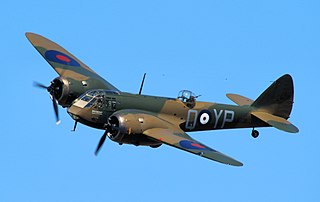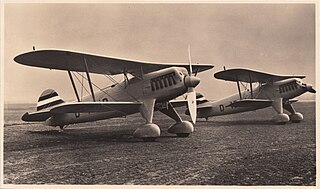Related Research Articles

The Luftwaffe was the aerial-warfare branch of the German Wehrmacht before and during World War II. Germany's military air arms during World War I, the Luftstreitkräfte of the Imperial Army and the Marine-Fliegerabteilung of the Imperial Navy, had been disbanded in May 1920 in accordance with the terms of the 1919 Treaty of Versailles which banned Germany from having any air force.

The Bristol Blenheim is a British light bomber aircraft designed and built by the Bristol Aeroplane Company (Bristol) which was used extensively in the first two years of the Second World War, with examples still being used as trainers until the end of the war. Development began with the Type 142, a civil airliner, in response to a challenge from Lord Rothermere to produce the fastest commercial aircraft in Europe. The Type 142 first flew in April 1935, and the Air Ministry, impressed by its performance, ordered a modified design as the Type 142M for the Royal Air Force (RAF) as a bomber. Deliveries of the newly named Blenheim to RAF squadrons commenced on 10 March 1937. In service the Type 142M became the Blenheim Mk.I which would be developed into the longer Type 149, designated the Blenheim Mk.IV, except in Canada where Fairchild Canada built the Type 149 under licence as the Bolingbroke. The Type 160 Bisley was also developed from the Blenheim, but was already obsolete when it entered service.

The Heinkel He 162 Volksjäger was a German single-engine, jet-powered fighter aircraft fielded by the Luftwaffe in World War II. Developed under the Emergency Fighter Program, it was designed and built quickly and made primarily of wood as metals were in very short supply and prioritised for other aircraft. Volksjäger was the Reich Air Ministry's official name for the government design program competition won by the He 162 design. Other names given to the plane include Salamander, which was the codename of its wing-construction program, and Spatz ("Sparrow"), which was the name given to the plane by the Heinkel aviation firm.

A night fighter is a fighter aircraft adapted for use at night or in other times of bad visibility. Night fighters began to be used in World War I and included types that were specifically modified to operate at night.

The CAC Boomerang is a fighter aircraft designed and manufactured in Australia by the Commonwealth Aircraft Corporation between 1942 and 1945. Approved for production shortly following the Empire of Japan's entry into the Second World War, the Boomerang was rapidly designed as to meet the urgent demands for fighter aircraft to equip the Royal Australian Air Force (RAAF). It was the first combat aircraft designed and constructed in Australia.

A medium bomber is a military bomber aircraft designed to operate with medium-sized bombloads over medium range distances; the name serves to distinguish this type from larger heavy bombers and smaller light bombers. Mediums generally carried about two tons of bombs, compared to light bombers that carried one ton, and heavies that carried four or more.

The Gloster E.28/39, was the first British jet-engined aircraft and first flew in 1941. It was the fourth jet to fly, after the German Heinkel He 178 (1939), the Italian Caproni Campini N.1 motorjet (1940), and the German Heinkel He 280 (1941).

Heinkel Flugzeugwerke was a German aircraft manufacturing company founded by and named after Ernst Heinkel. It is noted for producing bomber aircraft for the Luftwaffe in World War II and for important contributions to high-speed flight, with the pioneering examples of a successful liquid-fueled rocket and a turbojet-powered aircraft in aviation history, with both Heinkel designs' first flights occurring shortly before the outbreak of World War II in Europe.

The Heinkel He 51 was a German single-seat biplane which was produced in a number of different versions. It was initially developed as a fighter; a seaplane variant and a ground-attack version were also developed. It was a development of the earlier He 49.

The Bristol Type 163 Buckingham was a British Second World War medium bomber for the Royal Air Force (RAF). Overtaken by events, it was built in small numbers and was used primarily for transport and liaison duties.

The Pratt & Whitney R-1830 Twin Wasp is an American air-cooled radial aircraft engine. It displaces 1,830 cu in (30.0 L) and its bore and stroke are both 5.5 in (140 mm). The design traces its history to 1929 experiments at Pratt & Whitney on twin-row designs. Production began in 1932 and it was widely used during the 1930s.

The Emergency Fighter Program was the program that resulted from a decision taken on July 3, 1944 by the Luftwaffe regarding the German aircraft manufacturing companies during the last year of the Third Reich.

The Heinkel HeS 011 or Heinkel-Hirth 109-011(HeS - Heinkel Strahltriebwerke) was an advanced World War II jet engine built by Heinkel-Hirth. It featured a unique compressor arrangement, starting with a low-compression impeller in the intake, followed by a "diagonal" stage similar to a centrifugal compressor, and then a three-stage axial compressor. Many of the German jet-powered aircraft designs at the end of the war were designed to use the HeS 011, but the HeS 011 engine was not ready for production before the war ended in Europe and only small numbers of prototypes were produced.

The FFVS J 22 was a Swedish single-engine fighter aircraft developed for the Swedish Air Force during World War II.

The CAC Wirraway was a training and general purpose military aircraft manufactured in Australia by the Commonwealth Aircraft Corporation (CAC) between 1939 and 1946. It was an Australian development of the North American NA-16 training aircraft. The Wirraway has been credited as being the foundation of Australian aircraft manufacturing.

The CANT Z.506 Airone was a trimotor floatplane produced by CANT from 1935. It served as a transport and postal aircraft with the Italian airline "Ala Littoria". It established 10 world records in 1936 and another 10 in 1937. During World War II it was used as a reconnaissance aircraft, bomber and air-sea rescue plane, by the Italian Regia Aeronautica and Regia Marina, Aeronautica Cobelligerante del Sud, Aeronautica Nazionale Repubblicana and the Luftwaffe. The military version revealed itself to be one of the best floatplanes ever built. Despite its wooden structure it was able to operate in very rough seas. A number of Z.506S air-sea rescue aircraft remained in service until 1959.

The VL Myrsky ("Storm") is a Finnish World War II fighter aircraft originally developed by Valtion lentokonetehdas for the Finnish Air Force. The models of the aircraft were Myrsky I, Myrsky II, and Myrsky III.

Valtion lentokonetehdas was a Finnish aircraft manufacturing company that was founded on 23 February 1928 from the IVL or I.V.L. factory, founded in 1921.

During World War II, aviation firmly established itself as a critical component of modern warfare from the Battle of Britain in the early stages to the great aircraft carrier battles between American and Japanese Pacific fleets and the final delivery of nuclear weapons. The major combatants – Germany and Japan on the one side and Britain, the United States and the USSR on the other – manufactured huge air forces which engaged in pitched battles both with each other and with the opposing ground forces. Bombing established itself as a major strategic force, and this was also the first war in which the aircraft carrier played a significant role.